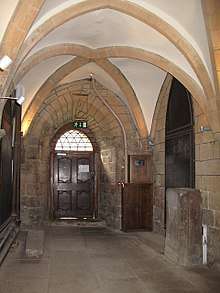Slype
The term slype is a variant of slip in the sense of a narrow passage; in architecture, the name for the covered passage usually found in monasteries or cathedrals between the transept and the chapter house, as at St Andrews, Winchester, Gloucester, Exeter, Durham and St. Albans. At St. Mary's Abbey, Dublin, it is, with the chapter house, one of only two remaining rooms.[1]
In general, the Benedictine chapter-house, as it took form in England, was an oblong room about twice as long as wide ... either north or south of the transept, from which it was separated by a narrow passage or chamber called a "slype."[2]
Its place is supplied by the Sacristry in Cistercian houses. It occurs in the Clugniac convent of Bromholme, and in that of Austin Canons at Newstead. At New college, Oxford, it is the passage between the backs of the houses and the city walls ....[3]

References
- "Archived copy". Archived from the original on 2015-04-16. Retrieved 2015-04-15.CS1 maint: archived copy as title (link)
- Phelps, Albert C. (April 1920). "The English Chapter-House". Architecture: The Professional Architectural Monthly. XLI (4): 97–101. (See page 98 for quote.)
- "Slype". The Dictionary of Architecture. vols. 7–8. 1887. p. 90.
